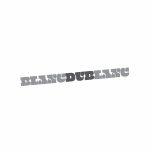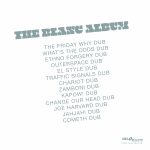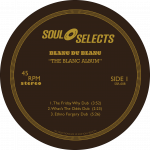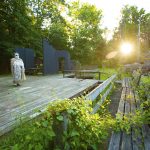“When somebody’s wearing a mask, he’s gonna tell you the truth. When he’s not wearing a mask, it’s highly unlikely.” – Bob Dylan (from Martin Scorsese’s Rolling Thunder Revue)
Let’s take a moment to project into the (hopefully not too distant) future, where you find yourself basking in the hue of moonlight with a clear, close view of a stage. Upon the stage are stacks of black speakers which promise to soon project pleasing vibrations to soothe your soul. People around you bustle with excitement, eagerly anticipating a unique experience, the exact likes of which have never been done before and never will be done again. To set the proper mood, the p.a. blares the drum and bass grooves and trippy sound effects of the esteemed dub reggae producer, King Tubby, or perhaps another from his ilk, like Scientist.
The p.a. fades out as the stage lights slowly illuminate. They cast a palette of pleasing colors which refract through the smoke that has accumulated from the copious amounts of ganja being inhaled by the crowd as well as from strategically-placed fog machines. Suddenly, the sound of a saxophone floats hesitantly through the ether; not the uplifting tones typically associated with reggae music, but subdued and moody, as if the player was yawning into his instrument, or perhaps under the influence of a heavy narcotic, such as morphine.
Into this spectacle steps a solitary figure holding a guitar, a figure that more closely resembles a Komondor crossed with a Sleestak than it does a human. With the dark notes of the sax still resonating, the figure coaxes some from his own instrument as he is joined on stage by a ragtag group of…others.
“Think Gorillaz meets Mardi Gras, and sprinkle in some of the Swedish metal band, Ghost with Teletubbies,” described veteran shape-shifting musician, Chris Harford, the musician wielding the guitar from whose wildly creative mind this cloaked collective, named Blanc du Blanc, was hatched. “Imagine, for the live Blanc du Blanc performance, a state-of-the-art light show, members of the band in costumes and masks, not unlike The Residents, though each costume is unique and designed to reflect the personality and spirit animal of a band member. The audience won’t see race or age — just colorful characters who are following a long tradition of costume wearing which fosters a sense of freedom and mystery.”
Harford alluded to the above referenced Bob Dylan quote from Martin Scorsese’s 2019 documentary, Rolling Thunder Revue, as a source of inspiration for his vision of Blanc du Blanc’s live show. “If you’ve watched that film, it’s likely Dylan is messing with us and could very well mean the opposite,” he said. “Nonetheless, the provocative statement got my wheels turning. I have been painting the past few years my version of a Chimera — in Greek mythology, a fire-breathing female monster with a lion’s head, a goat’s body and a serpent’s tail. The artist and photographer Andrew Wilkinson, who captured the image of Blanc (the character/costume pictured with this article to be donned by Harford on stage), turned me on to this series of photographs by Charles Freger. These images of costumes and masks from different cultures around the world are endlessly fascinating.”
For now, we will have to wait for the Blanc du Blanc live show. However, thanks to high fidelity recording technology, we can enjoy the audible aspect of his creation, the debut of which, titled The Blanc Album, will be releasing on limited edition vinyl and streaming platforms this Friday.
For those of you unfamiliar with Harford, he has been putting out recorded music that touches upon a variety of genres since last century. As referenced by Wikipedia, The New Yorker magazine described his music perfectly: “He has a foot in country, a hand in seventies rock, a toe in folk, a finger in post-punk.” Now, with the advent of his latest collective, we can add “a (insert body part that makes sense…a nose? Chin?) in dub reggae.”
Beyond his solo work, more recently, Harford is well known in the jam band scene for his Band of Changes, which he has described himself as “a constantly evolving, consistently changing series of musical performances by a band that never plays the same songs in the same way twice.”
Frequent collaborator and apex drummer, Joe Russo (Joe Russo’s Almost Dead, Furthur), referred to Harford during a 2016 interview with Jambands.com as “one of the most amazing and influential musicians I’ve been lucky enough to have in my life,” adding, “Chris is just one of those people whose energy and passion for what he’s doing is contagious. I have rarely had more fun on stage than when I’m playing with The Band of Changes. It’s raw, pensive, playful, painful, spirited and violent all wrapped up in one thing.”
Like his Band of Changes, Blanc du Blanc will feature a revolving cast of musicians, including Russo and fellow JRAD bandmate Scott Metzger on a future release. For this initial album, Harford recruited keyboardist wizard Marco Benevento (also of JRAD), Dana Colley of Morphine on saxophone and Chuck Treece, a professional skateboarder and session musician who has played with Rasta punk outfit Bad Brains and other bands, who contributes some guitar and drums on several tracks.
So what led Harford into the reggae genre? His love affair with reggae music runs deep into his past, starting when, along with an elementary school friend, he discovered Bob Marley & The Wailers’ debut album, Catch a Fire, in his sister’s vinyl collection. This led him in 1978 at the age of 17 to the now demolished Spectrum in Philadelphia to see Marley perform with The Wailers, which was “a mind-bending experience.” Two years later, living in Boston, Harford was in a band that opened for British 2-Tone luminaries, The English Beat. “The seeds were firmly planted,” recalled Harford. “I visited Jamaica, seen and heard the sound systems, and got hooked.”
Continuing, Chalkie Davies, who took the album cover photographs for the first two Specials records, gave him a thumb drive with “enough reggae and dub to last a lifetime.” Then, a housemate of Jon March, his partner in Soul Selects (Harford’s label releasing Blanc du Blanc) burned him twelve CDs from his Jamaican 45” and 12″ collection. “Listening became a spiritual journey,” he said. “A kind of gospel music. It was the music I listened to all day, whether I was driving, walking or hanging at home. Once I heard Pablo Moses’ “Dubbing Is A Must,” it was on.”
Given that Harford has worked with a sizable cadre of musicians over the years, I was curious how he selected the musicians to collaborate with on this record. He immediately expressed gratitude toward his friend Mickey Melchiondo (aka Dean Ween of alt-rock band, Ween), who graciously let them record at his studio, and praised recording engineer Gabe Monago. “This debut, The Blanc Album, wouldn’t have been possible without Gabe,” Harford said. “He has been a road technician for Ween as well as the likes of Katy Perry, and he is an endless font of musical knowledge and inspiration.”
Harford referred to Dana Colley, the Morphine saxophonist he had quickly befriended while attending Massachusetts College of Art in the 80s, as “the linchpin of the Blanc sound.” His relationship with Kevin Salem, who had played guitar on several of his early formations of the Band of Changes, also dates back to his Boston days.
About Marco Benevento, he said, “With his easy fluidity, kind nature and go-with-the-flow vibe, made for an obvious choice to include.”
Continuing, he said, “Mickey had told me several times that Chuck Treece would be the perfect drummer for any sessions I was looking to do, and lo and behold, one evening at the studio, I found myself being introduced to Chuck, and without saying more than a few words we were recording.”
And what was the process for recording this album? Did it adhere to Harford’s penchant for improvisation, or were the tunes fully written ahead of time?
“We made the songs up on the spot,” Harford related. “Sometimes, while driving to the studio, I may have conjured some chord structures in my head, but most of it came spontaneously after hitting the record button. Generally, we started with the drums, and I’d lay down a bass, guitar or keyboard.”
He expanded on how they had spent time in the studio: “Gabe has an ever-expanding collection of 45s, which supposedly feature early recordings of Jimi Hendrix as a session musician. I listened intently to the songs while Gabe expounded on the producers and the cities in which they were recorded. In between him dropping the needle, I would ask him to record me laying down a drum groove, then a bass line, and over a course of the next ten hours or so, in between stories of Hendrix, we’d have the makings of a dub track. We were making it up as we went.”
In the world of dub reggae, musicians and producers commonly rely heavily on vintage/analog tools & techniques, but that isn’t the case of Blanc du Blanc. Unlike recent releases from Flying Vipers or Crown-Lites that used antique equipment, The Blanc Album clearly comes from the digital age and brings to mind producers that use a more modern approach, like Bill Laswell.
This was not as much a stylistic choice but driven by the equipment available in the studios he had been given access to by the generosity of his friends. “To have the luxury of mixing in true dub fashion with live faders is something I very much look forward to,” he said. “I’m not sure what process a producer such as Brett Tubin (aka Channel Tubes) uses, though it’s clear his sound is gorgeously vintage. I hope someday to work with him in some capacity. Though Deaner’s studio has plenty of vintage gear, a Neve board, Echoplexes and many vintage keyboards, it’s set up is the modern way in that everything runs through Protools. It was the same way mixing with Adam Lasus at Studio Red in West Hollywood, CA.”
He continued, “As these are my friends doing studio favors, it’s not like I’m going to say, ‘Hey, can we rewire your studio so we can be hands-on?’ And though I miss hands-on knob-turning and tape-reel-spinning, we made up for it by turning the knobs of the Echoplex, Roland Space Echo and my reliable Korg ToneWorks 301 Dynamic Echo. Watching footage of Lee Perry muting knobs, turning even bigger ones, and manually riding faders in a live mix is what my mind’s ear envisioned. In reality, we patiently went through the process of editing and mixing while viewing a screen.”
Analog or not, Blanc du Blanc presents a captivating audio journey, the type of music that offers best results through headphones. It commands an active listening session, and like a fine wine, gets better over time. Ostensibly, the recorded music does not change, yet each listen brings new surprises and fresh experiences.
For their initial release of The Blanc Album LP, Blanc du Blanc will be pressing 500 copies of a double album that spins at 45 rpm. Harford explains that this decision came down to Scott Anthony, the mastering engineer, informing him that the length was cutting it close in getting the music to fit while still retaining the quality at 33 rpm. He advised that if they pressed it at 45rpm, “it would sound like ‘jet fuel’ given the space between the grooves.”
Sounds like a must-have for any dub collector!
Looking ahead to the near future, Blanc du Blanc already has more releases planned on their Soul Selects label. In mid-December, they will drop a four-song EP with three different versions of The Scorpions’ “Wind of Change,” including a mix done by dub god Lee Perry. Next, in the first half of 2021, dub fans can expect another LP, titled Regatta du Blanc du Blanc. A little further down the road, contingent upon the pandemic of course, Blanc du Blanc hopes to make the scenario pictured at the beginning of this article a reality. Enhanced by massive amplification, wicked lighting effects and the ability to improv, their live show will certainly dazzle concertgoers.
Today, one day in advance of The Blanc Album’s official release on vinyl and streaming services, Rootfire premieres the track, “Traffic Signals Dub.” The Blanc Album can be purchased on vinyl and downloaded on the artist’s Bandcamp page. Rootfire is giving away three copies of The Blanc Album. For a chance to win, enter the contest using the form below.
Did you enjoy this story? Consider donating to Rootfire to help bring more stories like it! DONATE HERE.






